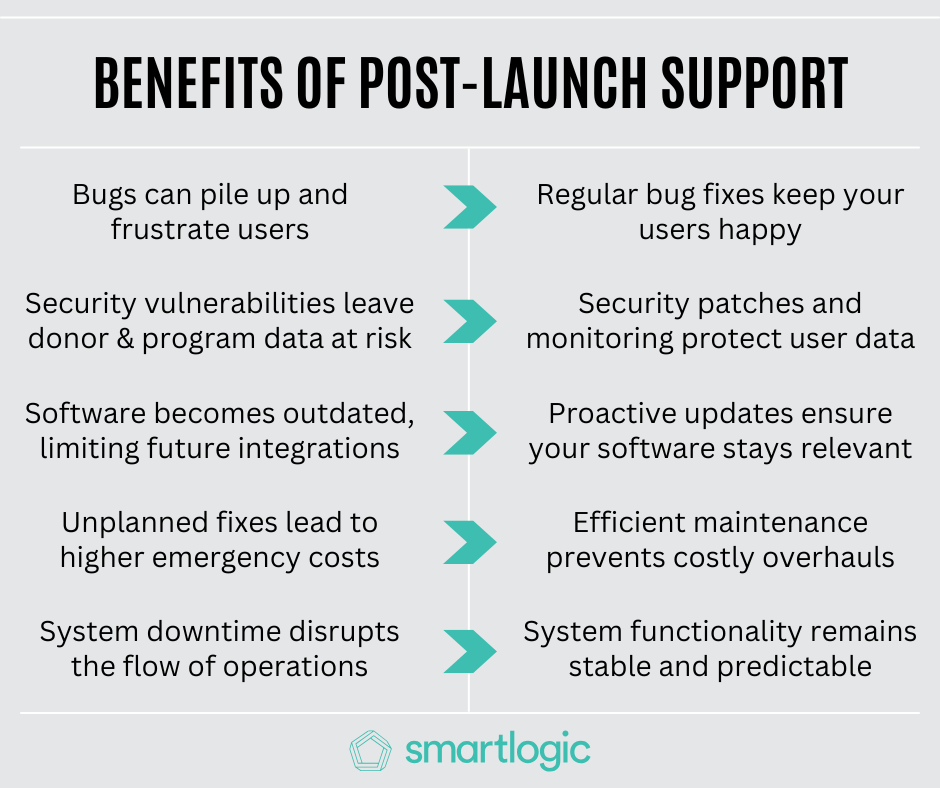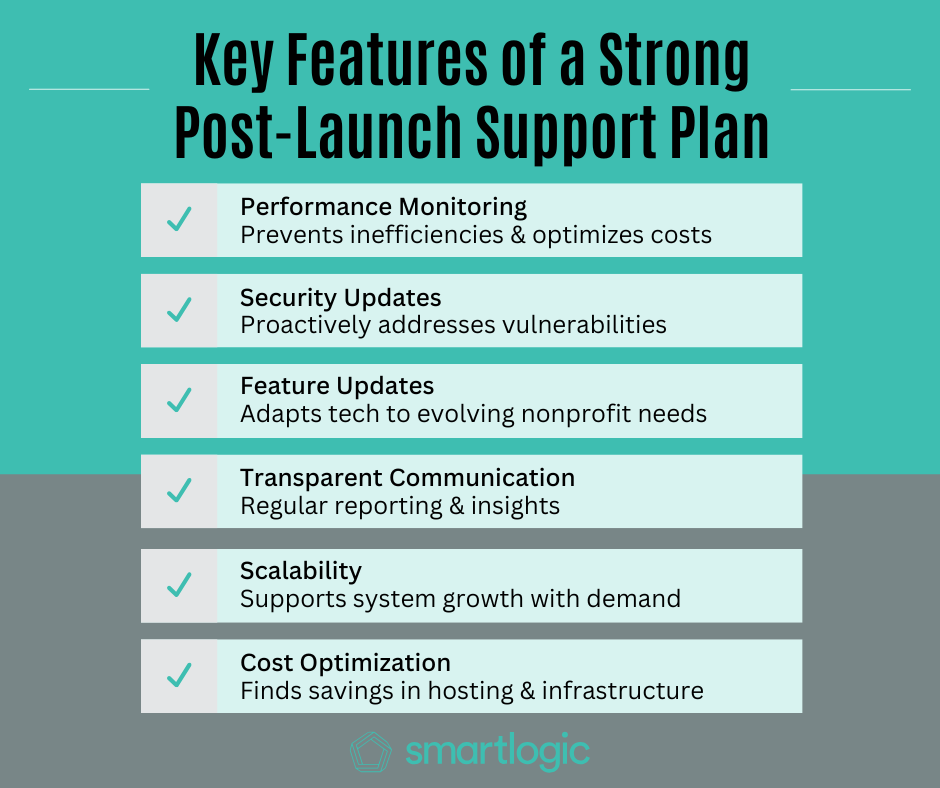The initial deployment of your nonprofit’s custom software isn’t the finish line—it’s the opening of a brand new chapter. What happens post-launch defines your app’s long-term success. While many nonprofits and businesses invest in software development, they often overlook the critical need for post-launch software support agreement. Without it, your organization risks facing frustrated users, operational inefficiencies, and diminishing returns on your investment.
In this post, we’ll detail why post-launch software support is essential, how it maximizes ROI, and what key features to look for in software maintenance services to protect your investment and achieve a lasting impact.

Your Software is Live—Now What?
Launching your nonprofit software is a huge milestone! But, you can't just set it and forget it. Before launch, the engineers and designers behind your platform conduct rigorous testing to deliver a seamless user experience. Still, even with the most meticulous planning, once real people start interacting with the system, edge cases and unforeseen challenges are inevitable.
Your nonprofit software evolves alongside your goals and your users’ needs. As your organization grows, new challenges and opportunities will inevitably arise and demand adaptability from your systems. Features that once worked flawlessly may be strained as your user base increases in volume. Launching new programs or expanding initiatives can also impact your software performance.
Some issues can only be revealed post-launch. Once users are active on your platform, bugs can emerge, bottlenecks can appear during periods of heavy traffic, and usability issues can be uncovered. Without post-launch support, these issues may go unaddressed and hinder your operations, frustrate your staff, and erode the trust of your users.
Address Risks and Build Resilience
Without regular maintenance, your software is vulnerable to malicious actors and technical risks. Every day, new security threats emerge. Outdated systems are the prime targets for security breaches that can jeopardize your donor and program data. Additionally, unsupported frameworks and libraries can cause compatibility issues when integrating new tools or leveraging system upgrades.
Unresolved issues don't go away, they actually compound over time. Without proper maintenance, your software can frustrate your staff, increase your tech debt, and stall your nonprofit's progress. The cost of neglected maintenance is beyond monetary, it prevents you from serving your community.
Luckily, with a software support agreement, you can avoid these common pitfalls. Regular software updates and performance monitoring prevent obsolescence. Well-maintained systems have a better ROI, and routine security patches keep your systems, and your users, secure.
How Ongoing Support Protects Your Investment
Post-launch support goes far beyond simply fixing bugs—it’s about keeping your software reliable, adaptable, and secure. Here’s how it helps your nonprofit thrive:
- Improved Performance: Post-launch support includes regular system diagnostics and performance tuning to address bugs, optimize speed, and maintain smooth operations. The support team monitors resource utilization, resolves database inefficiencies, and fine-tunes APIs to handle higher loads. Proactive performance monitoring identifies bottlenecks and resolves them before they escalate to keep your platform functional during heavy user traffic.
- Adaptability to Change: As your nonprofit grows, post-launch updates keep your software up-to-date with new demands. Supporting engineers integrate third-party tools, add modules, and reconfigure workflows to meet your needs. Effective versioning strategies allow for upgrades without disrupting the user experience.
- Security Updates: New cybersecurity threats emerge on a daily basis and target vulnerabilities in outdated frameworks, plugins, and libraries. Post-launch support mitigates this risk with regular patches, dependency audits, and updates in compliance with the latest security standards. Penetration testing and real-time monitoring add extra layers of protection for donor and program data.
- User Satisfaction: Frustrated users can stall adoption and productivity. Post-launch support prioritizes real-time usability improvements, interface refinements, and cross-platform compatibility. Accessibility compliance (e.g., WCAG standards) is also addressed to expand the reach and usability of your software.
Read Accessible UX Design: Unlock the Power of Web Accessibility to learn more about software accessibility standards.
- Cost Savings: Proactive maintenance prevents expensive, reactive fixes and avoids disruptions by addressing potential issues before they affect your users. Regular codebase reviews lower technical debt, while automated processes—such as backups and update rollouts—further improve cost efficiency.
What Happens When You Skip Support?
Neglecting post-launch software support can have serious consequences for your organization’s operational efficiency and growth:
- Technical Debt: Unaddressed bugs and outdated code can snowball into larger, more expensive issues over time. Missing security updates, for example, can cause cascading failures if malicious actors exploit a known vulnerability. Inadequate database maintenance can lead to data corruption or slow retrieval times as datasets grow.
- User Drop-Off: Poor experiences, such as sluggish response times or broken functionalities, erode trust and lead to disengagement. For example, a fundraising platform with repeated payment gateway errors may deter donors from completing transactions.
- Security Risks: Outdated systems are prime targets for malware and ransomware attacks. Without regular vulnerability scans, dependency updates, or encryption protocol improvements, sensitive data is left exposed, which puts compliance and donor trust at risk.
- Missed Opportunities: Without regular updates, your software may struggle to integrate with new systems or support evolving organizational needs. For instance, failure to add mobile-friendly features could alienate users increasingly reliant on smartphones for communication and engagement.
Inadequate support can lead to costly disruptions. Downtime from improper maintenance will not just stall your operations, it will impact your ability to deliver on your mission. For nonprofits, these risks extend beyond financial costs to negatively impact the communities you serve.
Building a Plan That Works for Your Nonprofit

A strong post-launch support plan keeps your software reliable, scalable, and cost-effective. When evaluating a support partner, prioritize these key features:
- Performance Monitoring: Keeping an eye on system performance allows you to catch and address resource utilization inefficiencies. With this information, your support team can optimize hosting and server costs. These funds can be reallocated to other initiatives.
- Security Updates: Proactive patching and dependency management mitigate risks before they become costly issues. Talk to your support team about conducting regular audits to identify vulnerabilities, maintaining compliance with industry standards, and avoiding the financial and reputational impact of breaches.
- Feature Updates: Flexible support allows you to add or enhance features based on user feedback and evolving organizational needs. Rather than waiting for the system to become outdated, incremental updates keep your software relevant to serve your mission effectively.
- Transparent Communication: A reliable partner provides clear, regular reporting on system health, cost-saving opportunities, and completed updates.
- Scalability: Your nonprofit’s needs will grow and change. Support plans should include strategies to optimize database performance, allocate resources efficiently during traffic spikes, and scale infrastructure as user demand increases.
- Cost Optimization: Beyond maintenance, your support partner should evaluate your hosting and infrastructure setup to identify cost-saving opportunities. For example, moving to a cloud-based environment or implementing auto-scaling can lower ongoing expenses by dynamically adjusting resources based on actual usage.
Read Signs It’s Time to Upgrade Your Business Software: From Refactoring to Cloud Migration to learn more about app modernization.
By combining proactive maintenance, performance optimization, and cost-saving strategies, a reliable support partner can help your nonprofit achieve lasting success without unnecessary overhead.
Protect Your Software Investment and Maximize ROI
Post-launch software support is not optional—it’s essential for maintaining secure, reliable, and impactful systems. By investing in a maintenance plan, your nonprofit can reduce costs, improve software performance, and ensure the long-term success of your mission-critical tools.
Ready to protect your software investment? Contact SmartLogic today to discuss how we can help your nonprofit maximize ROI with tailored support services.

